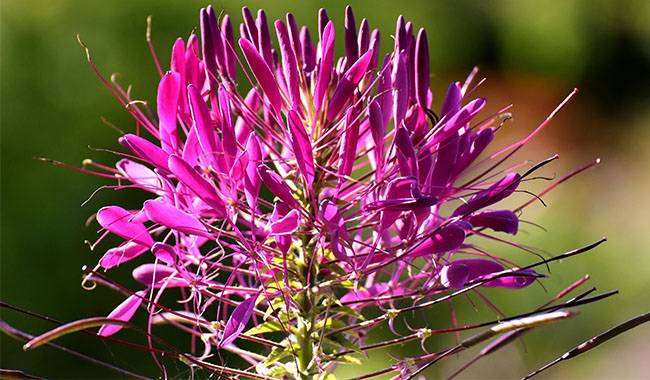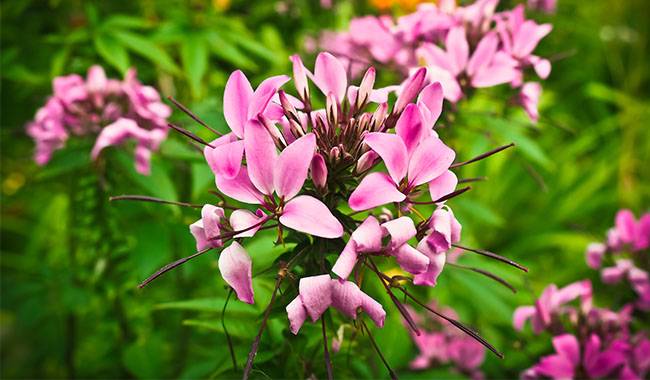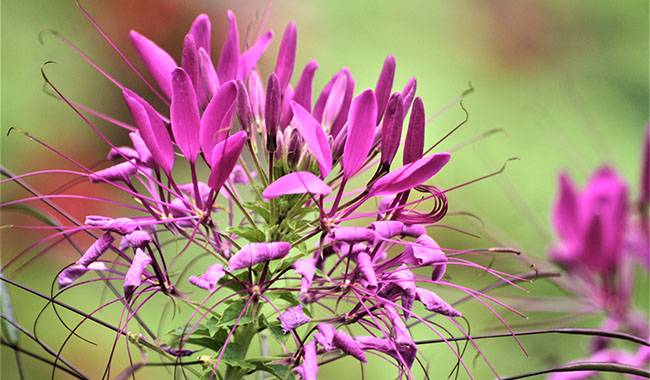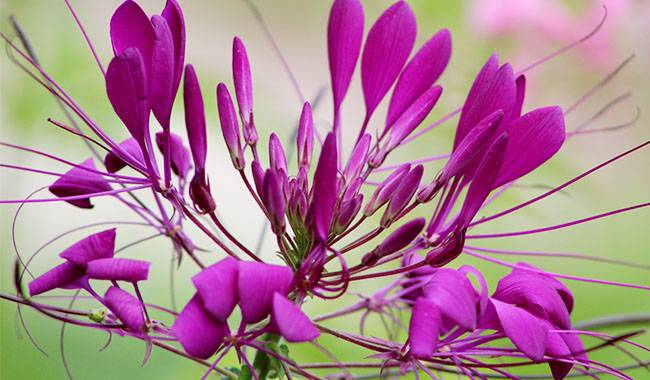
Cleomes (Spider flower) are probably the least popular annuals (for plants sold in home improvement stores and nurseries), probably because they look rather cluttered.
Cleome is a fascinating plant with unique characteristics. Many of you may ask: how to grow cleome?
It is tall but not too tall, has unusual but inconspicuous flowers, and requires little (if any) care during the growing season.
It will undoubtedly start some conversations with your neighbors who are not familiar with it. Its flowers come in white, pink, or pinkish-purple and can be used as a decorative feature in almost any garden.
Unlike the pretty marigolds or dazzling New Guinea anemones, clematis usually doesn’t start blooming until they’re well established in the garden.
Once the flower clusters appear, you’ll see why gardeners add them to their list of easy-care favorites. Many petals radiate from a central point to form a cluster, which is often the size of a softball.
The long stamens give the flowers a sharp look. Even the foliage is attractive, as it is delicate like a fern.
Without further ado, let’s find out what Cleome is and what you can do with it in your landscape.
WHAT IS CLEOME?
Cleome, sometimes referred to as spiderwort, spider plant (not to be confused with Chlorophytum comosum), or grandfather’s beard, will usually reach a height of 5 feet, although dwarf cultivars exist.
It grows as an annual in most U.S. growing zones, although it is a perennial in USDA hardiness zones 10 and 11.
It is a relatively unique plant because of the way it blooms and the length of time it takes to bloom – from early summer until the first frost.
The flowers grow in open racemes with a loose cluster of florets at the end of each stem. The long stamens make it look like a “spider”.
Mature stems have a nasty thorn at the base of each green leaf. After blooming, the dry flower heads attract birds and provide texture in the fall garden.
Cleome is often confused with a similar plant, the clam steppe (Polanisia dodecandra).
Clammy Grass is native to North America, while Cleome is native to South America.
CHARACTERISTICS AND HISTORY OF CLEOME
Cleome is a genus of about 170 species in the Capsicum family (Capparaceae).
The spider flower, Cleome hassleriana (sometimes incorrectly called C. hasslerana or by the synonym C. Spinosa) is a common annual flower of South America (Paraguay, Uruguay, Argentina, and southern Brazil) and is also known by other common names, including spider’s legs and grandfather’s whiskers.
The common name spiderflower comes from the appearance of the long, thread-like stamens of the individual flowers and the elongated seed pods that develop underneath after flowering. The spider flower has been a garden favorite since the 19th century.
This tender annual plant grows rapidly from seed to form tall, strong stems that can grow up to 6 feet (182 cm) tall from a stout taproot.
The plants branch easily and can grow as tall as they are if given enough room. The alternate leaves are palmately compound, with 5-7 leaflets that taper at the base (although the leaves on the upper part of the stem are smaller and simpler).
The leaves have spines on the midrib below, a pair of small spiny stipules at the base of each petiole (some varieties are spinier than others), and glandular hairs, so the aromatic leaves are slightly sticky with exudate and the glandular hairs have a foxy odor.
Many people suggest that the plants have a slight skunk smell. The lower leaves often fall at the end of the season.
After planting, flowering begins in mid-summer and continues until mid to late fall. For earlier flowering, allow cleome seeds to germinate indoors.
cleome will produce pink, purple, and white flowers. They are beautiful cut flowers and attract butterflies, hummingbirds, and bees.
TIPS FOR PLANTING CLEOME
Cleome is ideal for container gardening, mixed borders, and cut flower gardens. cleome is easy to grow in well-lit, well-drained soil conditions.
Gardeners have made a habit of planting sunflowers in partial sun to see how they respond and have lots of good luck.
While it can tolerate heavy soil, it is happiest in lighter soil conditions. The key factor here is that the soil should be rich in organic matter.
Cleome requires only a minimum of fertilization. You can accomplish it every year by simply adding compost to the growing bed.
Gardeners are not advised to use any fast-acting fertilizers, as this can lead to “leggy” growth.
It is more tolerant of drought conditions than many other annuals. Despite its impressive height, it doesn’t even need staking because it has a deep, strong taproot and sturdy stems.
As long as you have sunny conditions and well-drained soil, it will thrive and C. hassleriana will happily do its thing with minimal effort on your part.
ABOUT CLEOME’S SELF-GARDENER SOWING
Cleome is easy to self-seed by gardeners. In some estate gardens where gardeners planted it three years ago, new seedlings appear every year without replanting or reseeding. It’s a great freebie in the gardener’s eyes.
The gardener never lets Cleome lose control over the gardener, but under the right conditions, it is possible. Alternatively, you can choose sterile hybrid cultivars and eliminate any danger of self-seeding.
However, if you grow flowers in tight conditions or prefer to keep your garden as tidy as possible, the gardener recommends removing the seed pods immediately after the flowers have finished flowering alone.
HOW TO SOW SEEDS

Getting C. hassleriana to germinate for the first time is easy, getting them to self-sow is even easier, and getting these plants to self-sow to produce more plants is even easier.
Starting from seed
The only conditions needed to start C. hassleriana from seed are proper light and adequate soil conditions, and the right timing – when you’re beyond any danger of frost.
Dig the soil loose, prepare the planting site, mix in some compost if you wish, and rake it flat.
Sow the seeds directly on the surface and cover with a light layer of soil, no more than 1/4 inch (0.6 cm) deep, as they need light to germinate.
Keep the soil moist but not soggy. The gardener will check the sown area daily and give it water only when it starts to dry out.
Seeds germinate quickly, in about a week. Thin them out so you’ve got a few inches between each plant; 6-8 inches (15-20cm) is best to give the plants room to spread.
Alternatively, you can start seeds indoors six weeks before the last frost date.
If you don’t have a sunny enough location for your seedlings to start indoors, you may want to start your seeds indoors eight weeks before the last frost date or use a grow light.
These seeds need fluctuating temperatures to germinate, with daytime temperatures of 75-85°F (23.8-29.4°C) and nighttime temperatures around 50°F (10°C) lower.
Transplant the seedlings to your desired location when they have grown two to four inches tall and all danger of frost has passed.
Harden the seedlings by leaving them outdoors for an hour or so each day before planting, gradually increasing the time over the course of a week.
When planting out, dig a hole as deep and wide as the root ball and gently place the seedlings in the ground 6-8 inches (15-20 cm) apart. Tamp down the soil and water well.
HOW TO GROW
Regular readers know that a gardener’s favorite plants are those that can be smothered without the gardener’s attention, and Cleome is on the gardener’s list. As mentioned earlier, it needs a full sun location and soil that is rich in organic matter and well-drained.
Aside from watering the young plants regularly until they are established, and removing seed heads if the gardener wishes, this plant requires little attention.
It does not need staking, will de-head itself, and requires little, if any, fertilization.
GROWING TIPS
Cleome can tolerate drought but is happiest with an occasional drink of water if the weather is dry for a long time. Plants do not need to be staked at any point in their life cycle.
Make sure the plant is located in an area that receives at least 6 hours of sunlight per day and is well-drained. There are no special requirements for fertilization, except to avoid fast-acting fertilizers. Note that most varieties have small, sharp spines on their stems.
CLEOME’S CARE
Light
Cleome flowers grow best in full sun, as the shade can cause them to grow so tall that they topple over.
If you start from transplants, you will see flowers from early summer to the first frost. Gardeners who start Cleomes from seed will usually see the first flowers in mid to late June, depending on the climate.
Soil
Cleomes grow best in average garden soil or well-drained garden loam.
Watering
Once established, comes are drought tolerant, making them a welcome addition to any garden.
By adding a 3″ (7.6cm) layer of organic mulch to their planting bed, you will further reduce their water needs.
Temperature and humidity
For successful germination, Cleomes need higher than normal temperatures. Fluctuating temperatures during the day and night are essential for optimal germination.
During the day, the temperature should be between 80-85°F (26.6-29.4°C); at night, the temperature should remain between 68-70°F (20-21°C) and the humidity should be between 90% and 100%.
As plants grow, temperatures can be reduced to 75-80°F (23.8-26.6°C) during the day and 60-65°F (15.5-18.3°C) at night. Cleomes are not frosted tolerant.
Fertilization
Fertilization is not necessary if well-drained soil and mulch are used.
Propagation of Cleomes
To grow Cleomes from seed, plow the bed as deeply as possible, break up the clumps of Cleomes, and rake it flat. Then use a hoe to dig small 4-foot (121 cm) holes in all directions.
If planting in rows, alternate the small holes so that the small hole in the second row falls between the small holes in the first row.
Place about 6 seeds in each hole and cover with 1/4 inch (0.6 cm) of soil. Plant the seeds in the spring as soon as you can till the ground. Plant directly outdoors, without a cold frame.
Don’t worry about frost. The seeds will germinate only after the weather warms up. If the ground freezes again after planting, it will not cause harm.
Many gardeners plant Cleomes seeds in late fall in the beds where they are to grow, eliminating that part of the work in the spring. However, when direct sowing in landscape gardens, wait until the last danger of frost has passed before planting.
GROWING CLEOMES IN CONTAINERS
You can grow Cleomes in large containers, but choose compact varieties, such as the “Sparkle” series, for best results.
Combine your potted Cleomes with mounding flowers (such as Bunsenia) and trailing flowers (such as Petunia) for the fullest and lushest look.
LANDSCAPE USES FOR CLEOMES
Cleomes’ flowers are a great choice for the back of a flower bed, where their sturdy stems can be hidden behind other plants, but their festive clusters can sway in the breeze above other annual flowers.
Plant Cleomes in groups of five or more to avoid the visual effect of “soldiers lined up in a row” that single plants provide.
Cleomes’ casual form makes it ideal for planting in cottage gardens or naturalized meadows. Mix Cleomes with zinnias, cosmos, black-eyed Susans, sage, or celandine.
All of these plants thrive in the same sunny conditions, and moderate irrigation is what Cleomes prefers.
PESTS AND PROBLEMS
Cleomes, like many annual flowers, are fairly low maintenance in terms of disease and pests.
Leaf-sucking insects, including whiteflies, thrips, and aphids, may disturb them, although serious damage is rare. You won’t see holes in the leaves, but rather limp, wilted leaves.
You may also notice honeydew, a sticky substance secreted by insects, on the leaves and ground. Try rinsing these pests with a steady stream of water.
In severe infestations, you can treat them with insecticidal oil or soap. Apply the insecticide on a cool, cloudy day, making sure to cover the underside of the leaves as well as the top. If necessary, make a second application 7 days later.
Mildew and rust can sometimes affect clematis. These diseases are more common in hot, humid weather. To control these diseases, plant clematis so that air can circulate freely between them.
Use drip irrigation rather than overhead sprinklers so that the leaves stay dry and any infected leaves are removed. If the problem becomes severe, you can spray the plants with a fungicide labeled to treat mildew or rust.





